TID:
Chris, it's nice to connect with you. Lets talk about this image.

CHRIS:
The project was called Summer's End, and I photographed
my father-in-law's final days as he succumbed to cancer. It
was as much a project about how we, the family, deal with
loss, deep love, and hope. These images I'm sharing came on
the last time I saw him alive. It was earlier in the day when I
made them. He passed away that night.
The project actually started when I'd stopped by after work
and had my camera with me. My son Jack had been at
their house with my wife since the morning and had gotten
use to seeing his grandfather in the bed by that point. Jack
had just turned three a couple months before. As I walked
into the dark room I saw Jack feeding his grandfather ice chips.
It was the last solid food he ever had. There was something
about watching my little baby taking care of his grandfather
and I snapped a few frames. That night at home I looked at
what I shot and started crying. I felt that I needed to do something
or say something and it hit me in the face that what I needed
to do was not show the agony or pain, but show the devotion,
love and life that was going on around that dark room.

TID:
You said you needed to do something, or say something. Why did
you feel that way, and what did you do about it?
CHRIS:
Over the years I’ve had assignments that dropped me into the
emotionally tumultuous lives of complete strangers. Some
really serious life and death issues, ya know? I never felt like a
vulture because I’ve always tried to establish a good relationship
right up front, but being in such a personal and intimate situation
with the focus of making a storytelling photo can make one feel
both exposed and vulnerable. I can only imagine what it must
feel like on the other end of the camera. The way I’ve always
handled these situations was to just to be me and be honest with
the subjects. I’m not an aggressive shooter by any means and,
maybe I shouldn’t admit this, but there have been many times when
I felt that making the image wasn’t worth the price the subjects
would have to pay and so I didn’t raise my lens. There is this
crazy balance in my mind, “What does making this image mean?
Will photographing the situation shed light on a larger issue that
needs to be addressed?” Then I hear myself reiterate something
I heard James Nachtwey say once, “If you don’t shoot it, who will?”

It all gets weighed together with the news value of the story and
the emotional place of the subject matter. Generally speaking,
the answer most often came back that the power of the intimate
situation provided a necessary moment to telling the larger story
that could have a profound impact if seen and so I snapped the
shutter.
But, what if it was my family... I really did think about that
sometimes when I was facing one of those situations. How would
I feel if someone was making a picture of me or a loved one
facing a serious situation? There is no easy answer. There never is.
So, when I walked into that room and saw Jack feeding his
grandfather ice chips I conjured up those questions again and
I had a really hard time answering them. But what dawned on
me was this: How could I make pictures of dying children or
victims of awful tragedy if I couldn’t focus a camera on the
people close to me too? And so I snapped the picture. It seemed
like too much of an important moment in the lives of everyone
involved not to be memorialized. Later that night when I started
reflecting on it and all the images I’ve ever made in similar
situations I felt like what I have been focused on for most of
my career was the tragedy right in front of me and not the life
that moves around it. Often it was the news of the day and that
mandated that I shoot from that more limited point of view. But
I started thinking, where there is pain and anguish there you can
also find love and compassion. That was the expression on Jack’s
young face and Pop’s sunken one.

So, I went back the next day to show my father-in-law, Pop,
the image and talk to him about what it meant and the realization
the photo brought to me about life revolving around him. It
wasn’t an easy discussion for me but he understood and knew
that telling it could help others be more at ease if they were in
his situation. He was so gracious.
And so, for the next few weeks of his life I focused on a story
of devotion, love, loss and rebirth.

TID:
You said in a previous email that you called the project "Summer's
End." Why did you name it that, and to what extent did you document
him?
CHRIS:
The name of the project is actually quite literal. Pop died as the
summer faded with most of his family keeping vigil at his home.
But it meant more to me too. Pop was always like the sunshine,
warm and happy. He filled a room with his shining smile. He was
summer in a body. I don’t think he liked the cold either, really.
He grew up in the Philippines and was happiest in brutal heat.
The other thing I liked about the title was this: it conjectured that
there would be something coming after summer. That life would
continue, just differently and just as beautiful if we care to look.
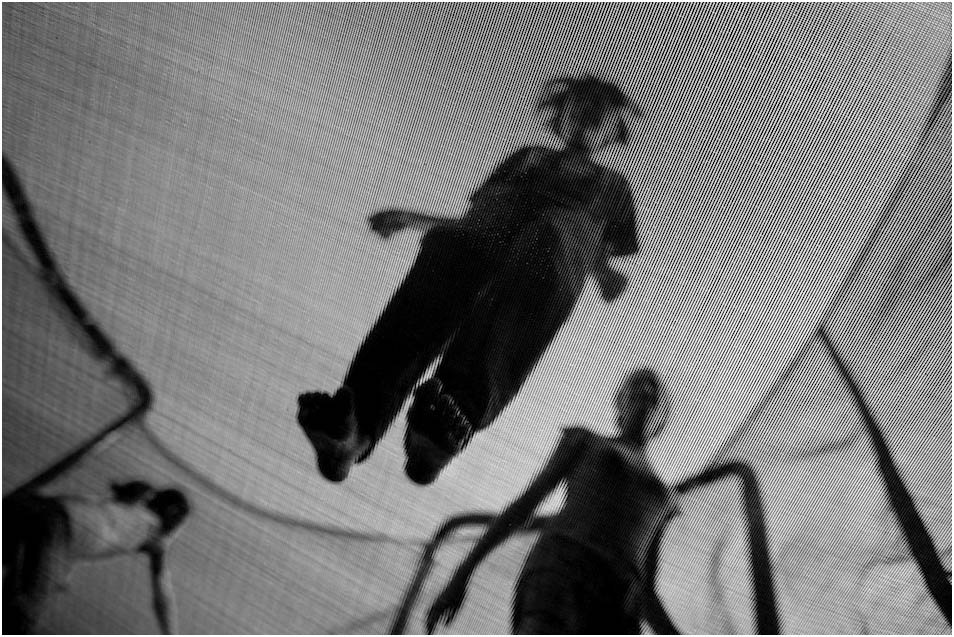
I was lucky that I was working at The Virginian-Pilot at the time
and was given time off not to necessarily work on this project, but
to also be there for my family. This was a pretty emotional time
for my wife as you can imagine. She loved him to pieces. So, I was
able to spend most of three weeks documenting this project. Many
times just spent sitting with him holding his hand and talking to
him about the times we spent rock hopping in El Paso, playing
golf and taking care of his “girls."
I think that is a really important lesson that is often overlooked or
an essential tool that separates the good from the great, that ability
to listen and be patient. To be in the moment and not necessarily
shooting it. When we are IN the moment, then everything we are
seeing, hearing, and feeling will come through the photographs
that follow and they will be powerful images that you can’t turn
away from.
TID:
Lets back up some. Did you have an initial thought to document
his final days, or did it stem from this day alone?
CHRIS:
Pop had been dealing with cancer for several months and though
I’d made a few pics here and there for some family events and
things, I guess I was shielding my innermost feelings and also
struggling with what to say visually about it that would add
anything new to the thinking about cancer or death.
I didn’t see the story that early and that was my mistake maybe.
I don’t know. Maybe it was fortunate that I didn’t see it so clearly
then and that it hit me near the end. Because for me, the focus
wasn’t about a person suffering from cancer, though that is certainly
an important subject, or a story about a person dying, as powerful
as that is. No, for me it was really about passion and love that
surrounded his bed in that dark room.
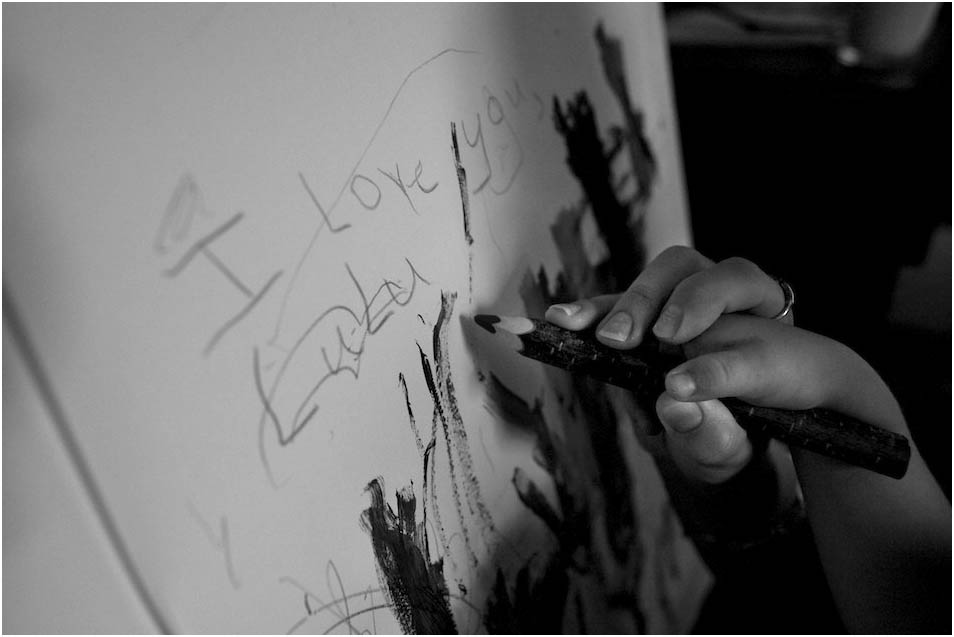
The whole project though stemmed from that image of Jack and
Pop. When I saw the love and the intimacy of the moment, I knew
what the focus would be and that I did have something to say with
my images that could be shared and contemplated for a deeper
understanding of what death means to all those involved. It was
the idea that there is so much love and life going on around him.
Ironically, I had already shot the bookend to this story on Pop a
year or so before when I photographed a story about Jane Does
and unclaimed bodies. How empty and sad that made me feel to
think about people who once were part of this community of life
and then were lost to the abyss with not so much as their name
placed on the ground above their name. Just a number, if even
that.
I thought about that story when I was looking at the picture I
made of Jack and Pop, it was a profound moment.
TID:
Now, lets talk about the image itself. Can you walk us through
your mental state that day before, as well as within, the moment.
CHRIS:
On the day this picture was made I’d actually gone into the
office to work and had an assignment to photograph at a
graveyard. I kind of remember thinking that that was a crappy
assignment given my circumstances but maybe it was just part
of the journey, ya know. I got over to Pop’s kind of late in the
afternoon and it was really quiet in the house. It seemed a bit
abnormal because for the previous three weeks there were people
constantly coming in and out, especially the grandkids.
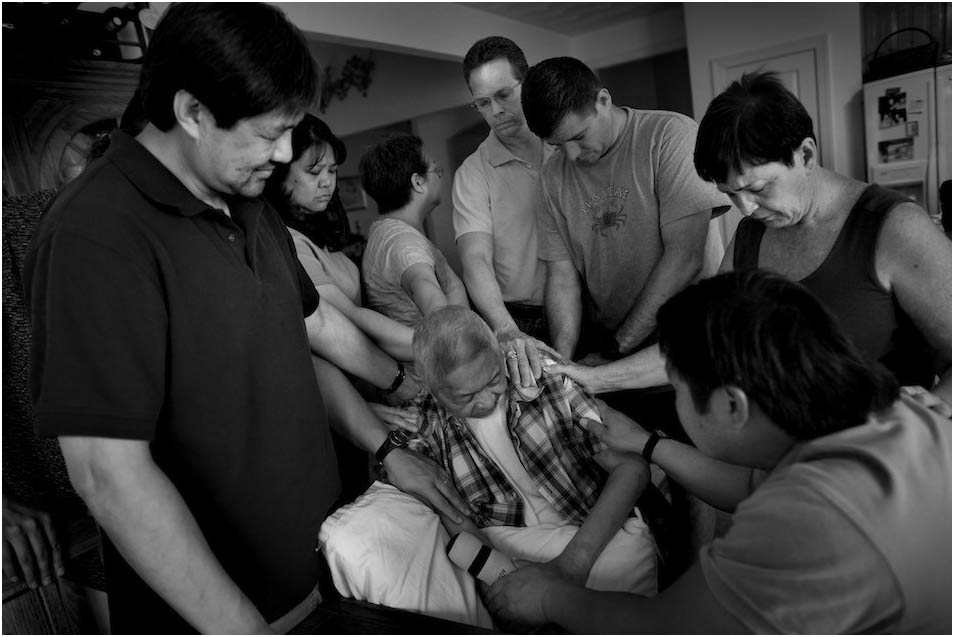
It was evident that the mood was heavier and Pop’s wife, Sandi,
my wife, Mel, and her sister, Olivia, were in the room with him
when I walked in. Mel was crying by herself nearby and Olivia
and Mom where nestled by his bed. I made a few pics then took
Mel out into the living room for a while to talk. Pop’s breathing
had become shallow and he was sleeping. I was kind of caught
needing to counsel but also feeling the need to document what
was going on. It was kind of confusing. While in the past I had
a single purpose to make the image, here I was feeling that
my duty was to be a support system first and photographer last.
And that is how it should be.
I could just tell that the pendulum had shifted and that the end
was imminent. So I was respectful and really just sat and prayed
out in the living room for a while. When I walked back in, Sandy
had crawled up in bed with her husband. This was the first time
I’d seen her do that and immediately took a frame, then I
remember starting to shoot the scene closer than I usually
would have because there was a tear in her eye and I was afraid the
moment would change. I needed to start close. After I made
that picture, I started to pull back. In the span of about 10 minutes
I made 30 frames. Then I put the camera down and just sat with
my family. That night I went home to take care of things at our
house while my wife stayed the night with Pop. About 1 am I got
a call that Pop had passed away. So that moment of them in bed
together, the unconditional love, the long goodbye, the simple
touch, and the fact that in the framing of this picture they form a
heart has stuck in my head like a brand on a cow. It is one of the
most important pictures I’ve ever made.
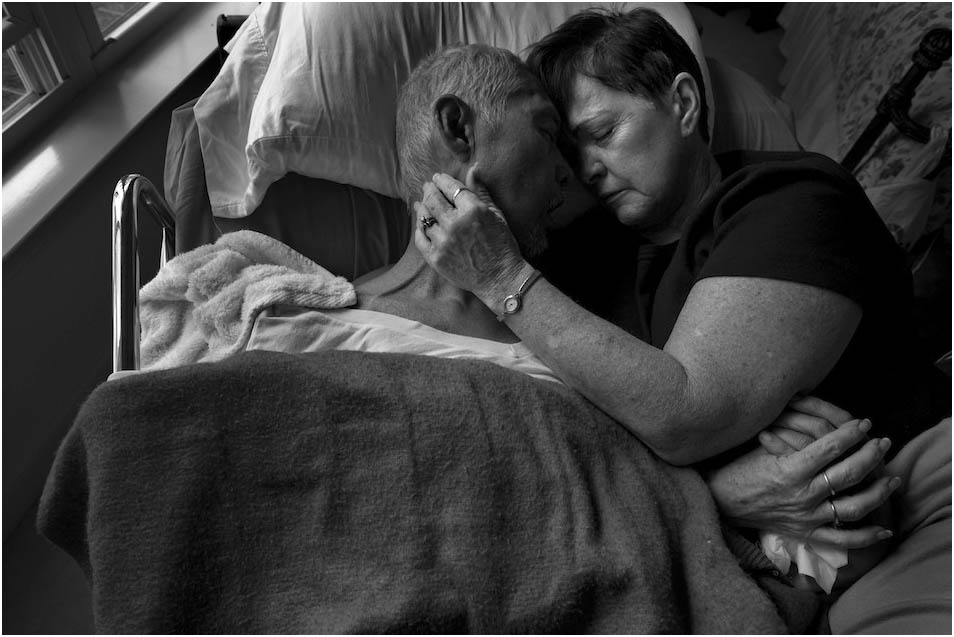
TID:
Were there any moments of tension during the making of this
image, or the story? If so, how did you handle it?
CHRIS:
Actually one thing I remember about this day was how quiet
and calm things were in the house. By the point this
picture was made, everyone was comfortable with me being
around with the camera. One thing I never do is constantly
stay in someone's face with a camera. I wait, listen and watch
and only shoot when there is a good or intimate moment. So
when I walked into the room, I knew things were different.
Generally there had been levity around the room every day,
kind of taking the edge off the hardness of the situation, but
not this day. It was serious and still. I think we all knew the
end was imminent and so the family was spending time saying
their goodbyes. If anything this moment was peaceful.
There was never any real tension with the family about telling
this story but there was tension in my own head and heart. I
was still struggling internally about whether this was too
personal or if I was doing the story justice. What was I really
trying to say with the story? All these things were bottled up
and I was working through them as the story progressed.
What I did was to look myself in the mirror and ask myself what
my motivation was. I asked, “What did I hope would happen by
telling this story?” I also had to be confident that I could be both
a supportive husband and a photographer. But supportive
husband first.
TID:
What did you learn about your family during the making of these
images that you didn't know before?
CHRIS:
I always knew how much everyone adored Pop. I knew they would
do anything for him. What I didn’t know was how much they
trusted me to give this project the level of excellence it deserved.
Everyone supported what I was doing and spent time talking to
me about it. Even though I occasionally felt like I was intruding
into really private situations, I was always welcomed.

Some might think it would be much easier to shoot a situation
like this in your own family because of the access, but I actually
found it harder because of how close I was to it. Harder because
my first inclination wasn’t always to take the picture but to offer
support or help out around the house. My focus wasn’t totally about
the photography and I kept having to refresh my mind about the
narrative I was trying to tell with the images.
About the only thing that surprised me was how Jack related to
this dramatic scene. At three, he was still a baby but somehow
he realized what was going on but it didn’t frighten him though
he was sad. He was so loving to his grandfather and would
spend hours spinning around in a chair beside his bed while
talking to him.
TID:
What did you learn about yourself?
CHRIS:
I always preach about taking risks and, for the most part, that is
what I’ve done my entire career. Not every risk panned out but
more often than not, the result was often worth the risk. Yet for
some reason, I just couldn’t step off the ledge this time to start the
project. As I reflect on it, I think I learned that I can and should
be more open with my feelings as they permeate through my
camera when the issues are so personal. I also learned that it is
very important to take time with really deep subject matter and
reflect on what you are seeing while trying to make sense of it.
If we are always “on” and not taking the time to let the emotions
burn through our eyes and into our hearts, then we are missing
a greater part of the journey.
The feedback after the story published was so overwhelmingly
positive that I learned that I should trust my instincts more often,
not be afraid to share my personal feelings. I learned that I can slow
down the shooting and be a human being first and a photojournalist
second and still make emotional, powerful and important pictures.
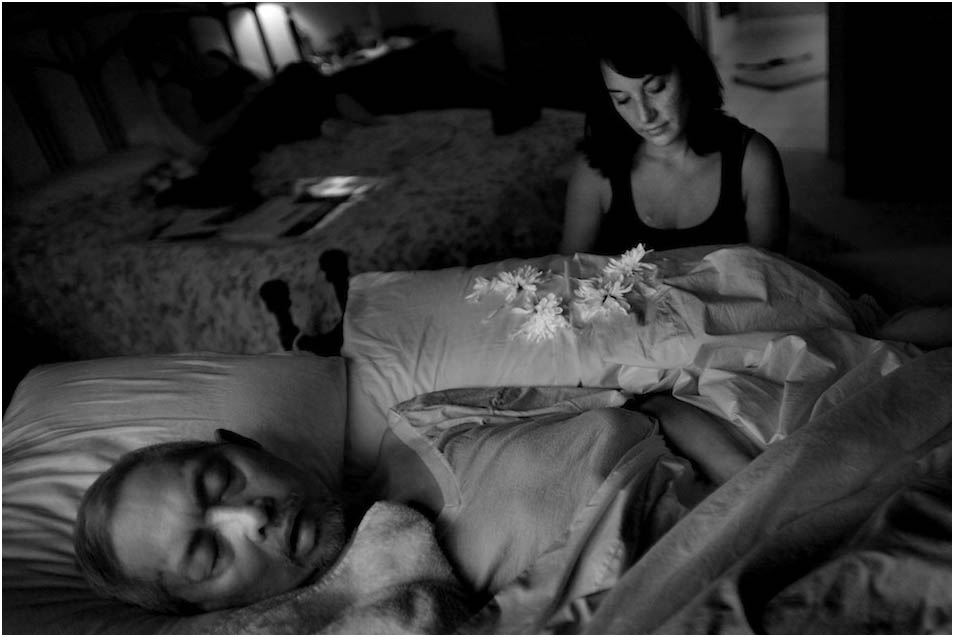
TID:
What would you do differently?
CHRIS:
I believe I bottled stuff up and didn’t trust myself to do this
project in the first place. I also felt like I wouldn’t do it well
enough. And felt like I would be doing my family an injustice.
If I had to do it all over again, I would have had the
conversation with Pop much earlier on.
But in some ways, while I made mistakes, it was all a learning
experience. Photography, like life, is nothing but a learning
experience. I’ve been shooting professionally for almost 20
years now and I’m constantly learning something new about
myself or about photography. The two are married. So I really
wouldn’t do anything differently, even if I knew the outcome
would be the same or better. That’s part of the journey. It is
also what makes me stronger in the future.
TID:
In general, how you do approach intimate situations like
this?
CHRIS:
Quietly. I remember when I was at Ohio University and our first
assignment in picture story class was to go out and tell a story
using one roll of film in one day. All but one of us did a process
story or place story. Really easy projects with no emotional value
whatsoever. But one of my friends came back with an amazing
group of emotional and intimate pictures of a child living with
HIV/Aids. Everyone was blown away. We asked him how he got
such moving images and he basically said that since he was
from Korea and didn’t speak English that great (at the time)
they never talked to him and he just melted into the fabric of
their lives. I’ve carried that lesson with me since then.
I believe in being upfront with what my goals are with the project
and how the images will be used. After that, I just listen, watch,
feel and wait for the defining moments. I don’t click the shutter
unless there is a good moment or a good reason to do so. I give
people space and then work my way closer. I use my body
language to communicate and watch theirs to see when I’ve
intruded too much and then I back off.
The easiest part is making the picture. It is everything that leads
you up to the decisive moment that makes you the kind of
photographer you are and frankly, the kind of person you are
too. I think the best photographers are those who are psychologists,
anthropologists, sociologists, physicists and a bunch of other “ists”
before they are photojournalists. You have to gage the situation,
the moods and expectations of your subjects, the importance of the
moment, the quality of light and then you have to reach deep into
that spirit within you to find your voice both narratively and
artistically. Then you can click.
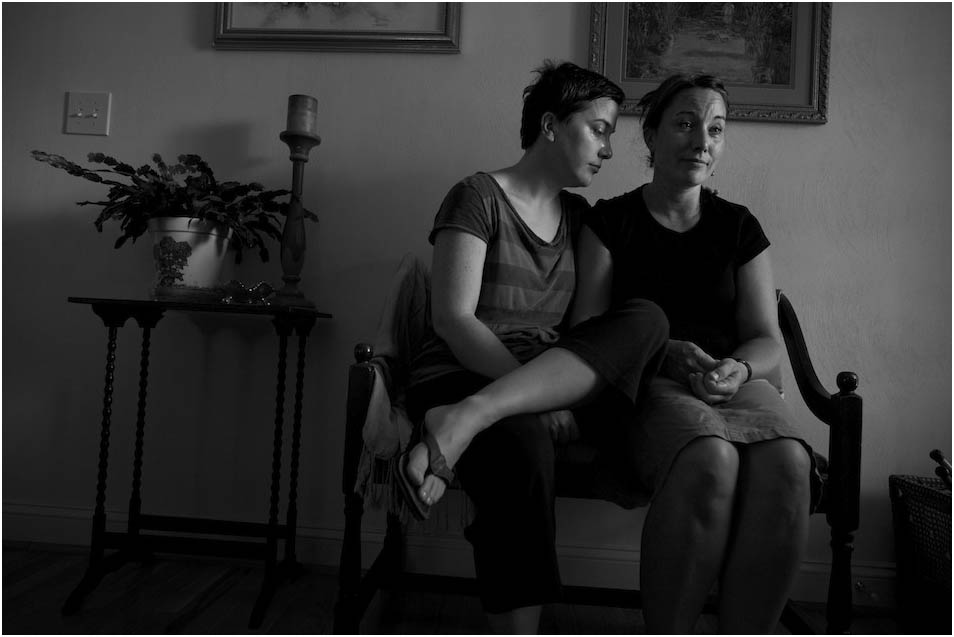
TID:
What suggestions do you have for photographers, especially
photographers who have never been in these situations?
CHRIS:
There are three things I think photographers should consider
when getting into a situation like this.
First, have a full and deep understanding of what and why. Look
yourself in the mirror and ask yourself if you are doing this
coverage for noble reasons. If you are doing it to pad a portfolio
or win awards, you suck. If you know that you are doing it to
raise awareness and/or interest and have thought about how
the images will be used in the end then you can go to number 2.
Secondly, put the subject of your story ahead of yourself. It isn’t
about you, though the way you see it and the narrative you bring
to it will have your voice. So remember to let the story speak
through you. Give the subject everything you have in terms of
your sensibility and heart.
Finally, don’t be afraid to not click the shutter. That is probably
the hardest thing to say and I’ll probably hear from a lot of people
that you shouldn’t be afraid to take the picture, but I disagree. If
you know your subject well and the story well, then you will know
exactly what you need to shoot and what to watch for. Sometimes
simply watching and being there for the subject is more important
to both them and you as you journey in life. It will be those
moments that you treasure because it showed your vulnerability
and emotional involvement. It is what makes you human.

+++++
Chris is the owner of Re:Act Media, director of Truth With A Camera Workshops and an award-winning documentary photographer, filmmaker and writer with more than 20 years of experience covering assignments on nearly every continent for a variety of publications and agencies. Integrity, perseverance, wit and curiosity have been the building blocks for his success.
He graduated with honors from James Madison University with a bachelor’s degree in communication and a minor in anthropology. He earned a master’s degree in visual communication from Ohio University. His photography and editing have been recognized nationally and internationally, earning him numerous awards from esteemed competitions, including Pictures of the Year international, National Press Photographers Association, The Society for News Design, and The Associated Press. Christopher’s photographs have been displayed in exhibitions across the country and are held in several private collections. His work has also been published in many of the nation’s major newspapers and magazines, including Time, Newsweek, and Mother Jones.
You can see his work here:
http://www.christyree.com/
+++++
Next week we'll feature this surprising and intimate image by Leah Nash:

As always, if you have a suggestion of someone, or an image you
want to know more about, contact Ross Taylor or Logan Mock-Bunting:
ross_taylor@hotmail.com
logan@scott-free.com
For FAQ about the blog see here:
http://www.imagedeconstructed.com/

"If you are doing it to pad a portfolio or win awards, you suck."
ReplyDeletethat made me laugh! which was nice..cos i was crying up until then.
a talented and noble person, this chris tyree.
That is the quote I was going to emphasize, too! I am glad everyone in the family understood what you were doing. Many of us have become cynical the way daytime talk shows and reality shows use emotion as theater. It is easy to lump all media in with those stunts. This is powerful and done with 100% sincerity. Thanks for allowing this time with your family.
ReplyDelete